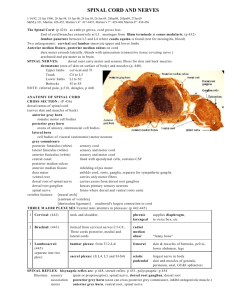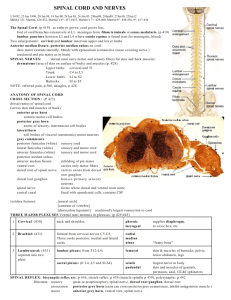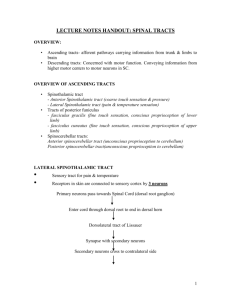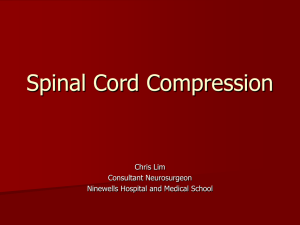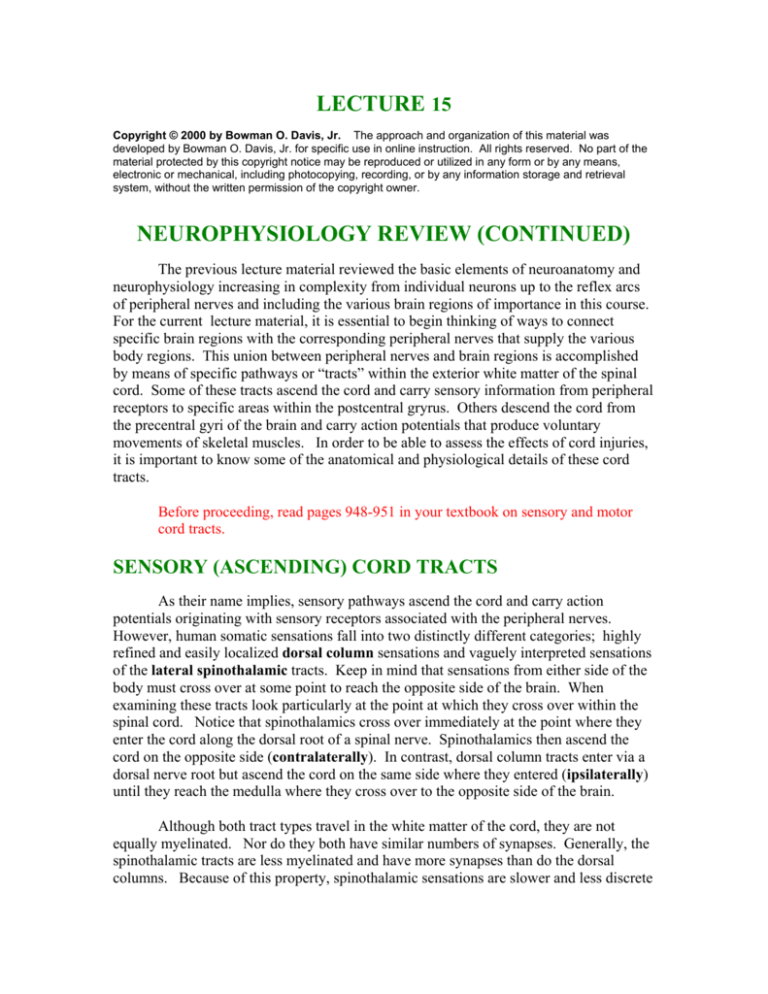
LECTURE 15
Copyright © 2000 by Bowman O. Davis, Jr. The approach and organization of this material was
developed by Bowman O. Davis, Jr. for specific use in online instruction. All rights reserved. No part of the
material protected by this copyright notice may be reproduced or utilized in any form or by any means,
electronic or mechanical, including photocopying, recording, or by any information storage and retrieval
system, without the written permission of the copyright owner.
NEUROPHYSIOLOGY REVIEW (CONTINUED)
The previous lecture material reviewed the basic elements of neuroanatomy and
neurophysiology increasing in complexity from individual neurons up to the reflex arcs
of peripheral nerves and including the various brain regions of importance in this course.
For the current lecture material, it is essential to begin thinking of ways to connect
specific brain regions with the corresponding peripheral nerves that supply the various
body regions. This union between peripheral nerves and brain regions is accomplished
by means of specific pathways or “tracts” within the exterior white matter of the spinal
cord. Some of these tracts ascend the cord and carry sensory information from peripheral
receptors to specific areas within the postcentral gryrus. Others descend the cord from
the precentral gyri of the brain and carry action potentials that produce voluntary
movements of skeletal muscles. In order to be able to assess the effects of cord injuries,
it is important to know some of the anatomical and physiological details of these cord
tracts.
Before proceeding, read pages 948-951 in your textbook on sensory and motor
cord tracts.
SENSORY (ASCENDING) CORD TRACTS
As their name implies, sensory pathways ascend the cord and carry action
potentials originating with sensory receptors associated with the peripheral nerves.
However, human somatic sensations fall into two distinctly different categories; highly
refined and easily localized dorsal column sensations and vaguely interpreted sensations
of the lateral spinothalamic tracts. Keep in mind that sensations from either side of the
body must cross over at some point to reach the opposite side of the brain. When
examining these tracts look particularly at the point at which they cross over within the
spinal cord. Notice that spinothalamics cross over immediately at the point where they
enter the cord along the dorsal root of a spinal nerve. Spinothalamics then ascend the
cord on the opposite side (contralaterally). In contrast, dorsal column tracts enter via a
dorsal nerve root but ascend the cord on the same side where they entered (ipsilaterally)
until they reach the medulla where they cross over to the opposite side of the brain.
Although both tract types travel in the white matter of the cord, they are not
equally myelinated. Nor do they both have similar numbers of synapses. Generally, the
spinothalamic tracts are less myelinated and have more synapses than do the dorsal
columns. Because of this property, spinothalamic sensations are slower and less discrete
(localized) than those of the dorsal columns. Dorsal column sensations can be easily
localized to the precise site of stimulation. Spinothalamic sensations are less discrete
and often can just be localized to the general area of stimulation.
Dorsal Column Tracts
The dorsal column (see Figure below) sensory neurons course through spinal
nerves from peripheral receptors and enter the cord through their dorsal roots. The
involved peripheral receptors are those that are responsible for refined touch/pressure and
kinesthetic senses. Refined touch sensations are exemplified by the precise sensation
involved in controlling the movement of a pen in order to make directional changes to
form letters while writing. Kinesthetic senses are those that inform the brain about
changes in body part positions. If an arm is moved, the brain must know to where and
whether or not the muscles involved are performing adequately to complete the task.
Thus, the brain always knows where every part of the body is at any point in time. From
these examples it can be seen that the neural information involved must be transmitted
quickly and precisely requiring pathways with few synapes and well myelinated.
Pay particular attention to the point at which crossing over of the dorsal column
tracts occurs. Since dorsal column tracts don’t cross until the medulla, unilateral damage
to one side of the cord yields sensory deficits on the same side as the injury (ipsilateral
deficit). Once in the brain and above the medulla, cross over is complete and brain injury
yields sensory deficits on the opposite side of the body (contralateral deficit).
PRACTICE ACTIVITY:
Draw a cylinder to represent the spinal cord and medulla and sketch in the path of the
dorsal column tracts on each side. Practice with speculative damage to the brain and/or
cord on either or both sides and be sure you can accurately predict the type and location
of expected deficits.
REVIEW QUESTIONS:
1. What anatomical features make dorsal column sensations easily localized and
quickly detected?
2. Describe in detail the deficits resulting from dorsal column damage on the left
side of the cord at the level of T-12.
Lateral Spinothalamic Tracts
As with the dorsal column system, the peripheral sensory neurons of the lateral
spinothalamic tracts travel within the spinal nerves joining the cord through their dorsal
roots. However, a major difference exists between the two sensory pathways with regard
to their crossover points. The lateral spinothalamic tracts cross to the opposite side
immediately upon entering the cord (see Figure above) and ascend to the postcentral
gyrus on the opposite side (contralaterally). So, damage to one side of the cord yields a
sensory deficit on the opposite side of the body from the injury. And, unilateral cord and
brain injuries yield similar deficits.
Since the spinothalamic tracts are somewhat less myelinated than the dorsal
column tracts and have more synapses, there are greater opportunities for divergence.
Consequently, by the time the information reaches the postcentral gyrus, it is so spread
out that the brain cannot easily localize the precise site of stimulation. For this reason,
spinothalamic sensations are those that are less of an emergency in nature. Touch and
pressure sensations traveling this route are referred to as “crude” because of their diffuse
nature. Not surprisingly, sexual sensations also travel to the brain along the lateral
spinothalamic tracts accounting for their diffuse nature.
PRACTICE EXERCISE:
Use the same cylinder that you drew for the dorsal column and now add the
spinothalamic tracts. Experiment with injuries to different sides of the cord and brain and
compare the deficits resulting from spinothalamic and dorsal column disruption with
regard to the side of the deficit and the type of sensation lost.
REVIEW QUESTIONS:
1. Compare and contrast the dorsal column and spinothalamic tracts with regard to
deficits resulting from a right side cord injury at T-12.
2. What anatomical features of the spinothalamic tracts explain the nature of
sensations they carry?
VOLUNTARY MOTOR (PYRAMIDAL) DESCENDING
TRACT
Being a descending, motor pathway, the pyramidal tract originates in the
precentral gyrus with cortical cells showing “pyramid shaped” cell bodies and descends
through the thalamus, middle and lower brainstem and cord to synapse with lower motor
neurons in the anterior horn gray matter of the cord. These lower motor neurons exit the
cord through the ventral (anterior) horns of spinal nerves and supply skeletal muscle
effectors (see Figure below).
Lower motor neurons are important as the “final common pathway” neurons in the
neural path to any given effector. They are termed “final” because they are the last
neurons in the chain leading from the brain to an effector (skeletal muscle in this case).
They are “common” in that all information getting to a given effector must cross these
neurons. For this reason, any damage to this neuron in the pathway leads to a type of
paralysis known as ‘flaccid paralysis.” Flaccid paralysis, as the name implies, literally
means no movement whatever. Logically, since all information to an effector must cross
this neuron, its failure means nothing reaches the effector and it becomes “flaccid.”
In contrast to the lower motor neurons, those which descend from the brain
through the cord to synapse with the lower motor neurons are termed “upper motor
neurons.” These neurons make up the corticospinal tracts of the cord and function
primarily to allow the brain to control the many spinal reflexes, of which the lower motor
neurons are the motor arms. Consequently, damage to these upper motor neurons causes
a type of paralysis known as “spastic paralysis.” Again aptly named because the
involved effector muscles do not become flaccid. Instead, they still respond to reflex
activity initiated by stimulation of receptors. There simply is no brain involvement and,
therefore, no control so they appear to react spastically.
A similar phenomenon as spastic paralysis can occur within the autonomic motor
pathways controlling blood vessel diameter. These autonomic fibers occur in spinal
nerves below the level of T-6 and, when active, cause arterial blood vessels of the body to
constrict (vasoconstriction). Their activation occurs normally through pathways
descending from the vasomotor center of the medulla through the cord, but they can be
activated reflexively by simple receptor stimulation if brain modulation is interrupted.
Consequently, cord injuries above T-6, which break the normal pathway from the
vasomotor center, leave blood vessels with no brain regulation and they dilate causing a
potentially dangerous drop in resistance and blood pressure. To make matters worse, any
seemingly insignificant stimulation, such as a full bladder or bowel, can cause a reflex
systemic vasoconstriction and raise blood pressure to dangerously high levels. This
phenomenon is known as sympathetic hyperreflexia or sympathetic dysreflexia, and is
noteworthy in clients with cord transections above T-6. Since the cervical cord is most
often damaged, blood pressure problems often occur with these clients.
PRACTICE EXERCISE:
Add the pyramidal tracts to your previously drawn “cylinder” and experiment with the
effects of damage to either side of the brain or cord.
REVIEW QUESTIONS:
1. Contrast the deficits resulting from cervical transections versus cervical
hemisections on one side or another.
2. Transecting the sciatic nerve to the leg in the femoral area would have what
effect? Why?
3. What is meant by paraplegia? Quadriplegia?
DISCUSSION QUESTIONS: (Post answers to the “Patho Discussion Group”)
1. Complete transection of the spinal cord above the lumbar plexus and sciatic nerve
would have what effects on the legs (be very specific)? Why?
2. Severing the sciatic nerve in the upper thigh would have what effects on the
affected leg (be very specific)? Why?



